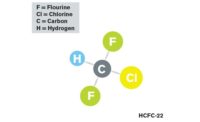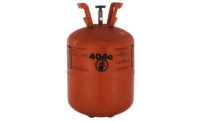For many years, hydrofluorocarbon (HFC)-134a was the alternate refrigerant of choice to replace chlorofluorocarbon (CFC)-12 in many medium- and high-temperature stationary refrigeration, air conditioning, and automotive air conditioning applications. The pressure/temperature relationship and the latent heat values of R-134a are very similar to those of R-12. Also, R-134a is a very safe refrigerant with an ASHRAE safety classification of A1. This means it is not flammable and has very low toxicity levels. Because HFC-134a has no chlorine in its molecule, it has a zero ozone-depletion potential (ODP) and doesn’t deplete the stratospheric ozone layer.
R-134a is not a refrigerant blend. It is considered a pure compound and has only one molecule. The R-134a molecule is ethane-based and consists of carbon (C), fluorine (F), and hydrogen (H).
EVAPORATOR TEMPERATURE APPLICATION
As a medium- and high-temperature refrigerant, R-134a is not usually used in low-temperature applications. R-134a loses some capacity when compared to R-12 in low-temperature applications. At lower temperatures, R-134a has a slightly lower pressure than R-12, and at higher temperatures, R-134a has a bit of a higher pressure when compared to R-12. Otherwise, both refrigerants’ pressure/temperature relationships closely compare.
R-134a often operates with a very low pressure — if not a slight vacuum — in low-temperature applications. At about minus 15°F evaporating temperature, R-134a starts to fall into a vacuum. These lower pressures in lower temperature applications cause higher compression ratios, higher discharge temperatures, and low efficiencies — not to mention added stress on a system’s compressor.
LUBRICANT
R-134a refrigeration systems use synthetic polyolester (POE) lubricants while the automotive industry typically has used polyalkylene glycol (PAG) lubricants. Polarity differences between commonly used organic mineral oils and HFC refrigerants make R-134a insoluble, thus incompatible with mineral oils that were used in many refrigeration and air conditioning applications. R-134a was never intended to be a direct drop-in replacement for any refrigerant, and retrofit guidelines had to be followed when retrofitting a system to R-134a.
GLOBAL WARMING LEGISLATION
R-134a has a global-warming potential (GWP) of 1,430. This means it traps 1,430 times as much heat per kilogram as carbon dioxide does over a 100-year period. Because R-134a has such a high GWP, the U.S. Environmental Protection Agency (EPA) listed R-134a as an “unacceptable” refrigerant for certain refrigeration and air conditioning applications under its Significant New Alternatives Policy (SNAP) program. These applications include:
- New light-duty motor vehicle air conditioning, starting in 2021, with a few narrow use limit exceptions. The exceptions are for newly manufactured light-duty vehicles destined for use in countries that do not have infrastructures in place for servicing with other acceptable refrigerants. The narrow use limit will continue through model year 2025;
- Beginning in model year 2026, R-134a will be unacceptable for use in all newly manufactured light-duty vehicles;
- New vending machines as of Jan. 1, 2019;
- New stand-alone, medium-temperature units with a compressor capacity below 2,200 Btuh not containing a flooded evaporator as of Jan. 1, 2019; and
- New stand-alone, medium-temperature units with a compressor capacity equal to or greater than 2,200 Btuh and stand-alone medium-temperature units containing a flooded evaporator as of Jan. 1, 2020.
SOME R-134a REPLACEMENT OPTIONS
There are a number of candidates to replace R-134a in the applications for which it will be deemed unacceptable by the EPA.
- HFO-1234yf — Hydrofluoroolefin (HFO)-1234yf is a low-GWP replacement for R-134a intended for use in mobile air conditioning systems in the automotive industry. It has an ODP of zero and a GWP of 4. HFO-1234yf’s GWP is more than 300 times less than that of R-134a. Many European and some U.S. car manufacturers are currently using HFO-1234yf for mobile air conditioning applications. HFO-1234yf has one of the lowest switching cost for automakers compared to other alternatives. It is classified as a low-toxicity but slightly flammable refrigerant by ASHRAE with an A2L safety classification. The continued development of standards and codes for safe use of mildly flammable A2L refrigerants is very important. HFO-1234yf is miscible in POE lubricants. The miscibility of HFOs with POE lubricants is comparable to that of R-134a. HFOs are not soluble in mineral oil or alkylbenzene lubricants.
- HFO-1234ze — HFO-1234ze can be used in vending machines, refrigerators, beverage dispensers, air dryers, and carbon dioxide cascade systems in commercial refrigeration. It has an ODP of zero and a GWP of 6. Other applications include both air- and water-cooled chillers in supermarkets and commercial buildings. HFO-1234ze offers excellent energy efficiency, is cost-effective, and can be used in existing equipment design with minimal changes. HFO-1234ze also offers advantages over R-32, which has a medium GWP, an A2 refrigerant safety rating, and high discharge temperatures. The miscibility of HFO-1234ze with POE lubricants is comparable to that of R-134a.
- HC-290 (Propane) — Hydrocarbon (HC)-290 has an A3 safety group classification, meaning it is highly flammable. Its molecule contains nothing but hydrogen and carbon. It has an ODP of zero and a GWP of 3. As long as the refrigerant charge doesn’t exceed 5.3 ounces (150 grams), it can be used in freezers, household refrigerators, combination refrigerators and freezers, room air conditioners, and vending machines. As with the A2L refrigerants, the continued development of standards and codes for safe use of flammable refrigerants is very important.
- HC-600a (Isobutane) — Like HC-290, HC-600a has an A3 (highly flammable) safety group classification. Its molecule contains hydrogen and carbon. It has an ODP of zero and a GWP of 3. As long as the refrigerant charge does not exceed 2 ounces (57 grams), it can be used in vending machines and retail food refrigeration (stand-alone commercial refrigerators and freezers). Again, the continued development of standards and codes for the safe use of HCs is very important.
- R-513A — R-513A is an HFO/HFC blend with an ODP of zero and a GWP of 631. R-513A has a close performance match to R-134a for new and retrofitted systems. It is the lowest GWP refrigerant in the A1 safety classification to replace R-134a in stationary systems.
- R-450A — R-450A is a near-azeotropic refrigerant blend containing an HFO refrigerant designed to replace R-134a in commercial and industrial refrigerators as well as air conditioning and chillers. It has a very low temperature glide and can be used in direct expansion or flooded evaporator systems. It is compatible with POE lubricants.
Publication date: 6/5/2017
Want more HVAC industry news and information? Join The NEWS on Facebook, Twitter, and LinkedIn today!







